MGT 520: Designing a Rater Training Program for Performance Report
VerifiedAdded on 2022/08/28
|6
|1667
|57
Report
AI Summary
This report addresses the need for a new rater training program within a Saudi Arabian company experiencing issues with its current performance management system, particularly regarding inaccurate and inconsistent ratings from customer service employees. The report critically analyzes the potential causes of rater errors, such as distributional errors and supervisor biases, and emphasizes the importance of aligning organizational goals with employee goals to improve performance. It recommends the implementation of a Frame-of-Reference (FOR) training program for supervisors, detailing its benefits in reducing rating errors, increasing rater accuracy, and enhancing the alignment between employee and organizational objectives. The report highlights the effectiveness of FOR training in providing a common reference point, establishing rating standards, and improving employee retention. The report also emphasizes the significance of evaluation training in ensuring the success of the overall performance management system.
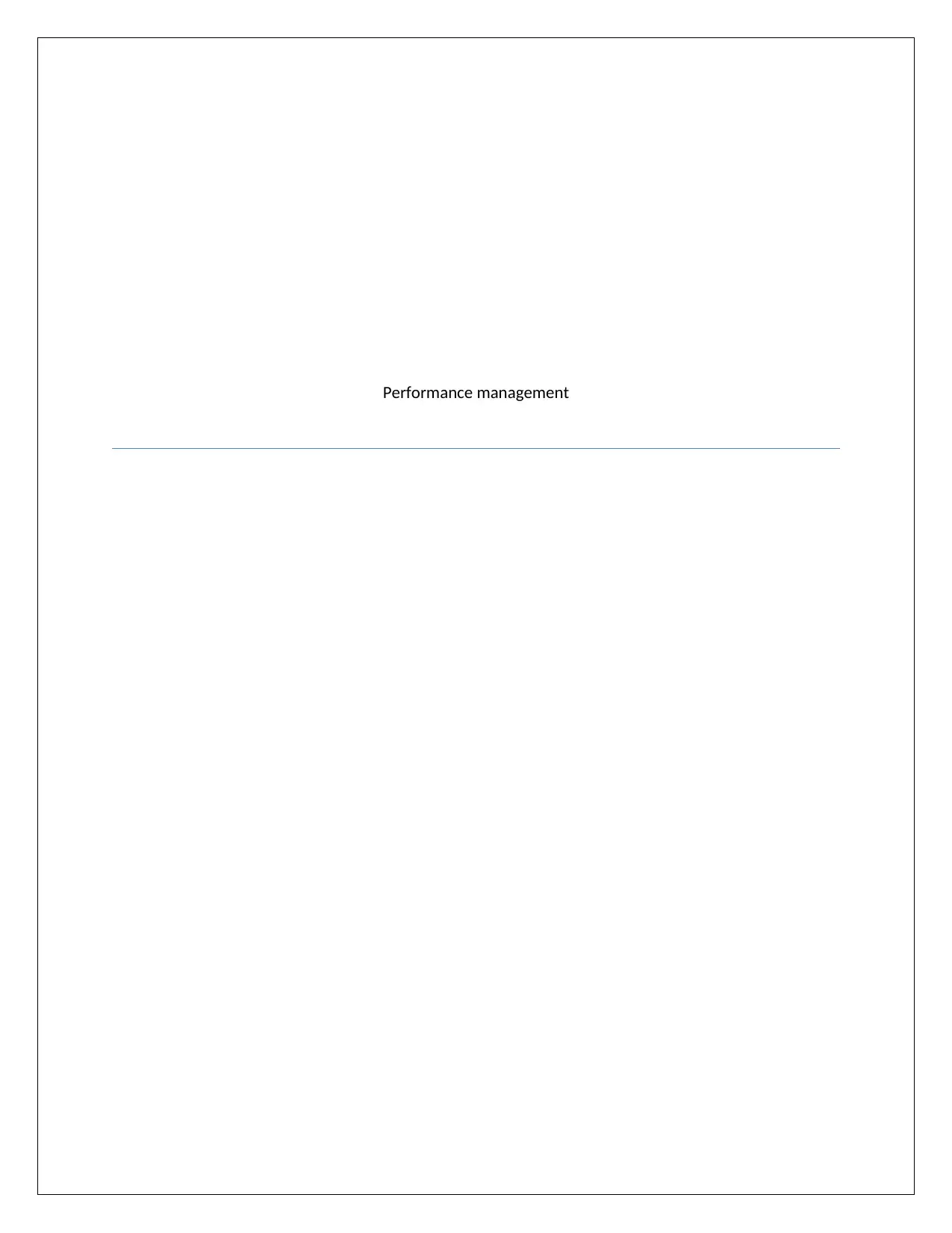
Performance management
Paraphrase This Document
Need a fresh take? Get an instant paraphrase of this document with our AI Paraphraser
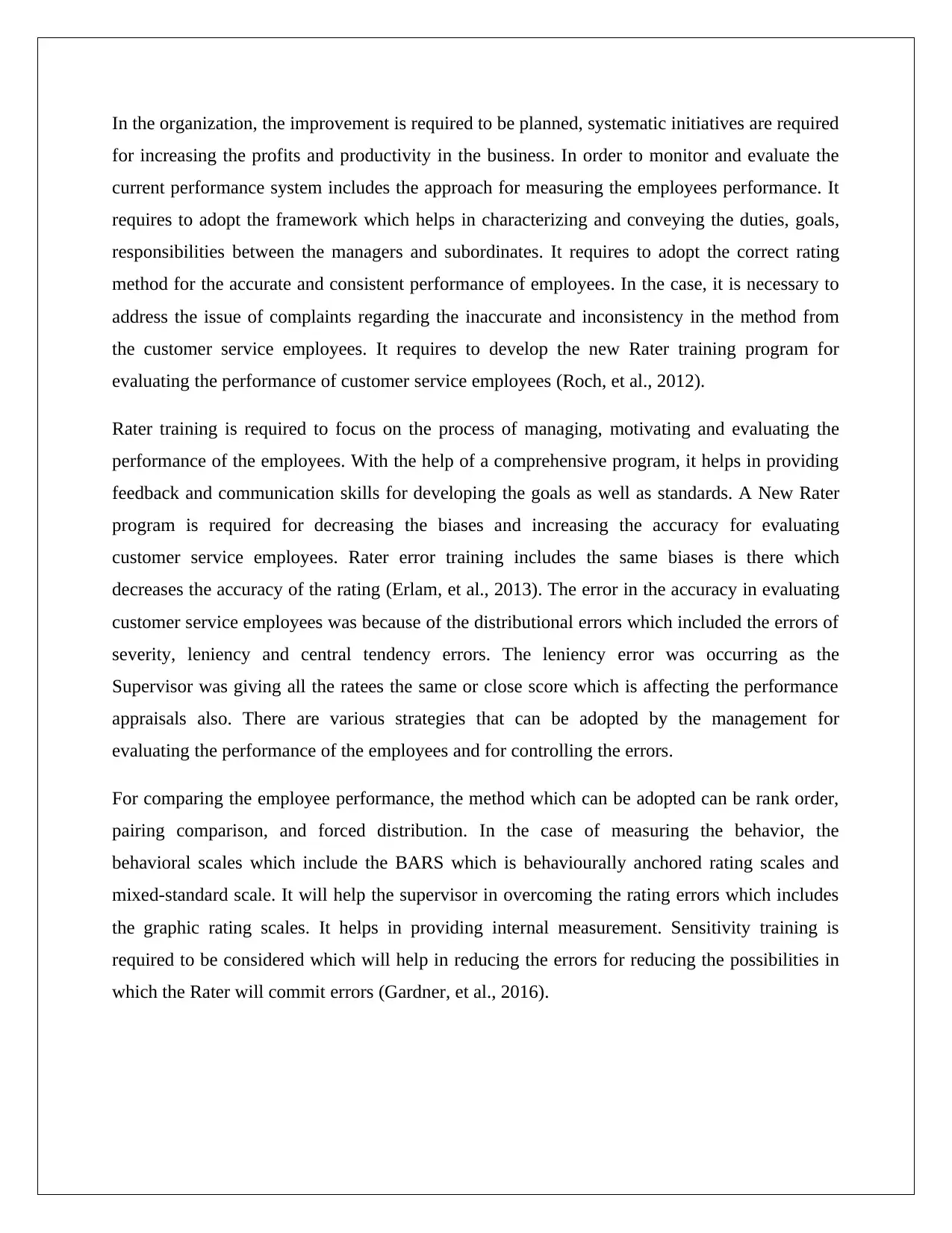
In the organization, the improvement is required to be planned, systematic initiatives are required
for increasing the profits and productivity in the business. In order to monitor and evaluate the
current performance system includes the approach for measuring the employees performance. It
requires to adopt the framework which helps in characterizing and conveying the duties, goals,
responsibilities between the managers and subordinates. It requires to adopt the correct rating
method for the accurate and consistent performance of employees. In the case, it is necessary to
address the issue of complaints regarding the inaccurate and inconsistency in the method from
the customer service employees. It requires to develop the new Rater training program for
evaluating the performance of customer service employees (Roch, et al., 2012).
Rater training is required to focus on the process of managing, motivating and evaluating the
performance of the employees. With the help of a comprehensive program, it helps in providing
feedback and communication skills for developing the goals as well as standards. A New Rater
program is required for decreasing the biases and increasing the accuracy for evaluating
customer service employees. Rater error training includes the same biases is there which
decreases the accuracy of the rating (Erlam, et al., 2013). The error in the accuracy in evaluating
customer service employees was because of the distributional errors which included the errors of
severity, leniency and central tendency errors. The leniency error was occurring as the
Supervisor was giving all the ratees the same or close score which is affecting the performance
appraisals also. There are various strategies that can be adopted by the management for
evaluating the performance of the employees and for controlling the errors.
For comparing the employee performance, the method which can be adopted can be rank order,
pairing comparison, and forced distribution. In the case of measuring the behavior, the
behavioral scales which include the BARS which is behaviourally anchored rating scales and
mixed-standard scale. It will help the supervisor in overcoming the rating errors which includes
the graphic rating scales. It helps in providing internal measurement. Sensitivity training is
required to be considered which will help in reducing the errors for reducing the possibilities in
which the Rater will commit errors (Gardner, et al., 2016).
for increasing the profits and productivity in the business. In order to monitor and evaluate the
current performance system includes the approach for measuring the employees performance. It
requires to adopt the framework which helps in characterizing and conveying the duties, goals,
responsibilities between the managers and subordinates. It requires to adopt the correct rating
method for the accurate and consistent performance of employees. In the case, it is necessary to
address the issue of complaints regarding the inaccurate and inconsistency in the method from
the customer service employees. It requires to develop the new Rater training program for
evaluating the performance of customer service employees (Roch, et al., 2012).
Rater training is required to focus on the process of managing, motivating and evaluating the
performance of the employees. With the help of a comprehensive program, it helps in providing
feedback and communication skills for developing the goals as well as standards. A New Rater
program is required for decreasing the biases and increasing the accuracy for evaluating
customer service employees. Rater error training includes the same biases is there which
decreases the accuracy of the rating (Erlam, et al., 2013). The error in the accuracy in evaluating
customer service employees was because of the distributional errors which included the errors of
severity, leniency and central tendency errors. The leniency error was occurring as the
Supervisor was giving all the ratees the same or close score which is affecting the performance
appraisals also. There are various strategies that can be adopted by the management for
evaluating the performance of the employees and for controlling the errors.
For comparing the employee performance, the method which can be adopted can be rank order,
pairing comparison, and forced distribution. In the case of measuring the behavior, the
behavioral scales which include the BARS which is behaviourally anchored rating scales and
mixed-standard scale. It will help the supervisor in overcoming the rating errors which includes
the graphic rating scales. It helps in providing internal measurement. Sensitivity training is
required to be considered which will help in reducing the errors for reducing the possibilities in
which the Rater will commit errors (Gardner, et al., 2016).
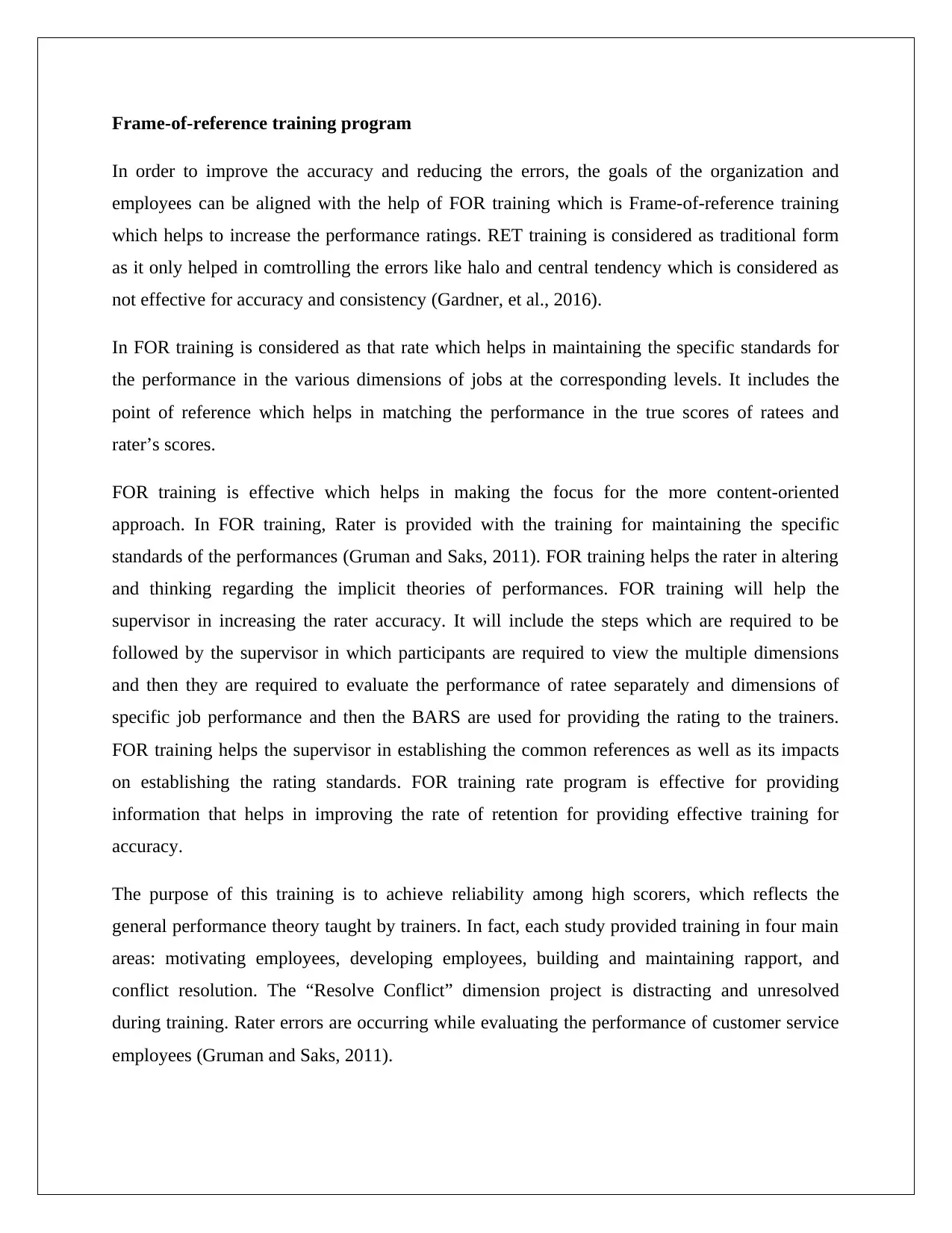
Frame-of-reference training program
In order to improve the accuracy and reducing the errors, the goals of the organization and
employees can be aligned with the help of FOR training which is Frame-of-reference training
which helps to increase the performance ratings. RET training is considered as traditional form
as it only helped in comtrolling the errors like halo and central tendency which is considered as
not effective for accuracy and consistency (Gardner, et al., 2016).
In FOR training is considered as that rate which helps in maintaining the specific standards for
the performance in the various dimensions of jobs at the corresponding levels. It includes the
point of reference which helps in matching the performance in the true scores of ratees and
rater’s scores.
FOR training is effective which helps in making the focus for the more content-oriented
approach. In FOR training, Rater is provided with the training for maintaining the specific
standards of the performances (Gruman and Saks, 2011). FOR training helps the rater in altering
and thinking regarding the implicit theories of performances. FOR training will help the
supervisor in increasing the rater accuracy. It will include the steps which are required to be
followed by the supervisor in which participants are required to view the multiple dimensions
and then they are required to evaluate the performance of ratee separately and dimensions of
specific job performance and then the BARS are used for providing the rating to the trainers.
FOR training helps the supervisor in establishing the common references as well as its impacts
on establishing the rating standards. FOR training rate program is effective for providing
information that helps in improving the rate of retention for providing effective training for
accuracy.
The purpose of this training is to achieve reliability among high scorers, which reflects the
general performance theory taught by trainers. In fact, each study provided training in four main
areas: motivating employees, developing employees, building and maintaining rapport, and
conflict resolution. The “Resolve Conflict” dimension project is distracting and unresolved
during training. Rater errors are occurring while evaluating the performance of customer service
employees (Gruman and Saks, 2011).
In order to improve the accuracy and reducing the errors, the goals of the organization and
employees can be aligned with the help of FOR training which is Frame-of-reference training
which helps to increase the performance ratings. RET training is considered as traditional form
as it only helped in comtrolling the errors like halo and central tendency which is considered as
not effective for accuracy and consistency (Gardner, et al., 2016).
In FOR training is considered as that rate which helps in maintaining the specific standards for
the performance in the various dimensions of jobs at the corresponding levels. It includes the
point of reference which helps in matching the performance in the true scores of ratees and
rater’s scores.
FOR training is effective which helps in making the focus for the more content-oriented
approach. In FOR training, Rater is provided with the training for maintaining the specific
standards of the performances (Gruman and Saks, 2011). FOR training helps the rater in altering
and thinking regarding the implicit theories of performances. FOR training will help the
supervisor in increasing the rater accuracy. It will include the steps which are required to be
followed by the supervisor in which participants are required to view the multiple dimensions
and then they are required to evaluate the performance of ratee separately and dimensions of
specific job performance and then the BARS are used for providing the rating to the trainers.
FOR training helps the supervisor in establishing the common references as well as its impacts
on establishing the rating standards. FOR training rate program is effective for providing
information that helps in improving the rate of retention for providing effective training for
accuracy.
The purpose of this training is to achieve reliability among high scorers, which reflects the
general performance theory taught by trainers. In fact, each study provided training in four main
areas: motivating employees, developing employees, building and maintaining rapport, and
conflict resolution. The “Resolve Conflict” dimension project is distracting and unresolved
during training. Rater errors are occurring while evaluating the performance of customer service
employees (Gruman and Saks, 2011).
⊘ This is a preview!⊘
Do you want full access?
Subscribe today to unlock all pages.

Trusted by 1+ million students worldwide
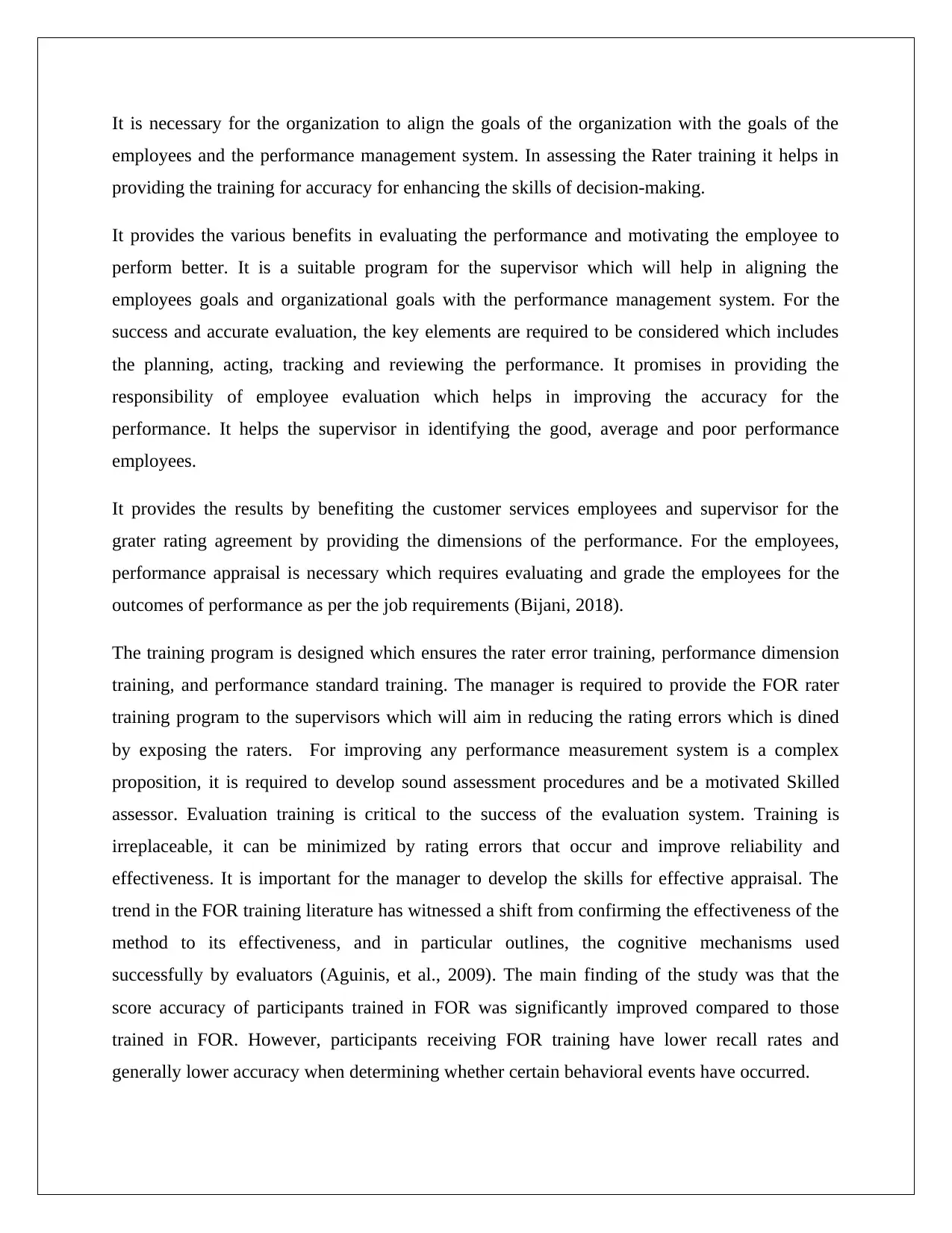
It is necessary for the organization to align the goals of the organization with the goals of the
employees and the performance management system. In assessing the Rater training it helps in
providing the training for accuracy for enhancing the skills of decision-making.
It provides the various benefits in evaluating the performance and motivating the employee to
perform better. It is a suitable program for the supervisor which will help in aligning the
employees goals and organizational goals with the performance management system. For the
success and accurate evaluation, the key elements are required to be considered which includes
the planning, acting, tracking and reviewing the performance. It promises in providing the
responsibility of employee evaluation which helps in improving the accuracy for the
performance. It helps the supervisor in identifying the good, average and poor performance
employees.
It provides the results by benefiting the customer services employees and supervisor for the
grater rating agreement by providing the dimensions of the performance. For the employees,
performance appraisal is necessary which requires evaluating and grade the employees for the
outcomes of performance as per the job requirements (Bijani, 2018).
The training program is designed which ensures the rater error training, performance dimension
training, and performance standard training. The manager is required to provide the FOR rater
training program to the supervisors which will aim in reducing the rating errors which is dined
by exposing the raters. For improving any performance measurement system is a complex
proposition, it is required to develop sound assessment procedures and be a motivated Skilled
assessor. Evaluation training is critical to the success of the evaluation system. Training is
irreplaceable, it can be minimized by rating errors that occur and improve reliability and
effectiveness. It is important for the manager to develop the skills for effective appraisal. The
trend in the FOR training literature has witnessed a shift from confirming the effectiveness of the
method to its effectiveness, and in particular outlines, the cognitive mechanisms used
successfully by evaluators (Aguinis, et al., 2009). The main finding of the study was that the
score accuracy of participants trained in FOR was significantly improved compared to those
trained in FOR. However, participants receiving FOR training have lower recall rates and
generally lower accuracy when determining whether certain behavioral events have occurred.
employees and the performance management system. In assessing the Rater training it helps in
providing the training for accuracy for enhancing the skills of decision-making.
It provides the various benefits in evaluating the performance and motivating the employee to
perform better. It is a suitable program for the supervisor which will help in aligning the
employees goals and organizational goals with the performance management system. For the
success and accurate evaluation, the key elements are required to be considered which includes
the planning, acting, tracking and reviewing the performance. It promises in providing the
responsibility of employee evaluation which helps in improving the accuracy for the
performance. It helps the supervisor in identifying the good, average and poor performance
employees.
It provides the results by benefiting the customer services employees and supervisor for the
grater rating agreement by providing the dimensions of the performance. For the employees,
performance appraisal is necessary which requires evaluating and grade the employees for the
outcomes of performance as per the job requirements (Bijani, 2018).
The training program is designed which ensures the rater error training, performance dimension
training, and performance standard training. The manager is required to provide the FOR rater
training program to the supervisors which will aim in reducing the rating errors which is dined
by exposing the raters. For improving any performance measurement system is a complex
proposition, it is required to develop sound assessment procedures and be a motivated Skilled
assessor. Evaluation training is critical to the success of the evaluation system. Training is
irreplaceable, it can be minimized by rating errors that occur and improve reliability and
effectiveness. It is important for the manager to develop the skills for effective appraisal. The
trend in the FOR training literature has witnessed a shift from confirming the effectiveness of the
method to its effectiveness, and in particular outlines, the cognitive mechanisms used
successfully by evaluators (Aguinis, et al., 2009). The main finding of the study was that the
score accuracy of participants trained in FOR was significantly improved compared to those
trained in FOR. However, participants receiving FOR training have lower recall rates and
generally lower accuracy when determining whether certain behavioral events have occurred.
Paraphrase This Document
Need a fresh take? Get an instant paraphrase of this document with our AI Paraphraser
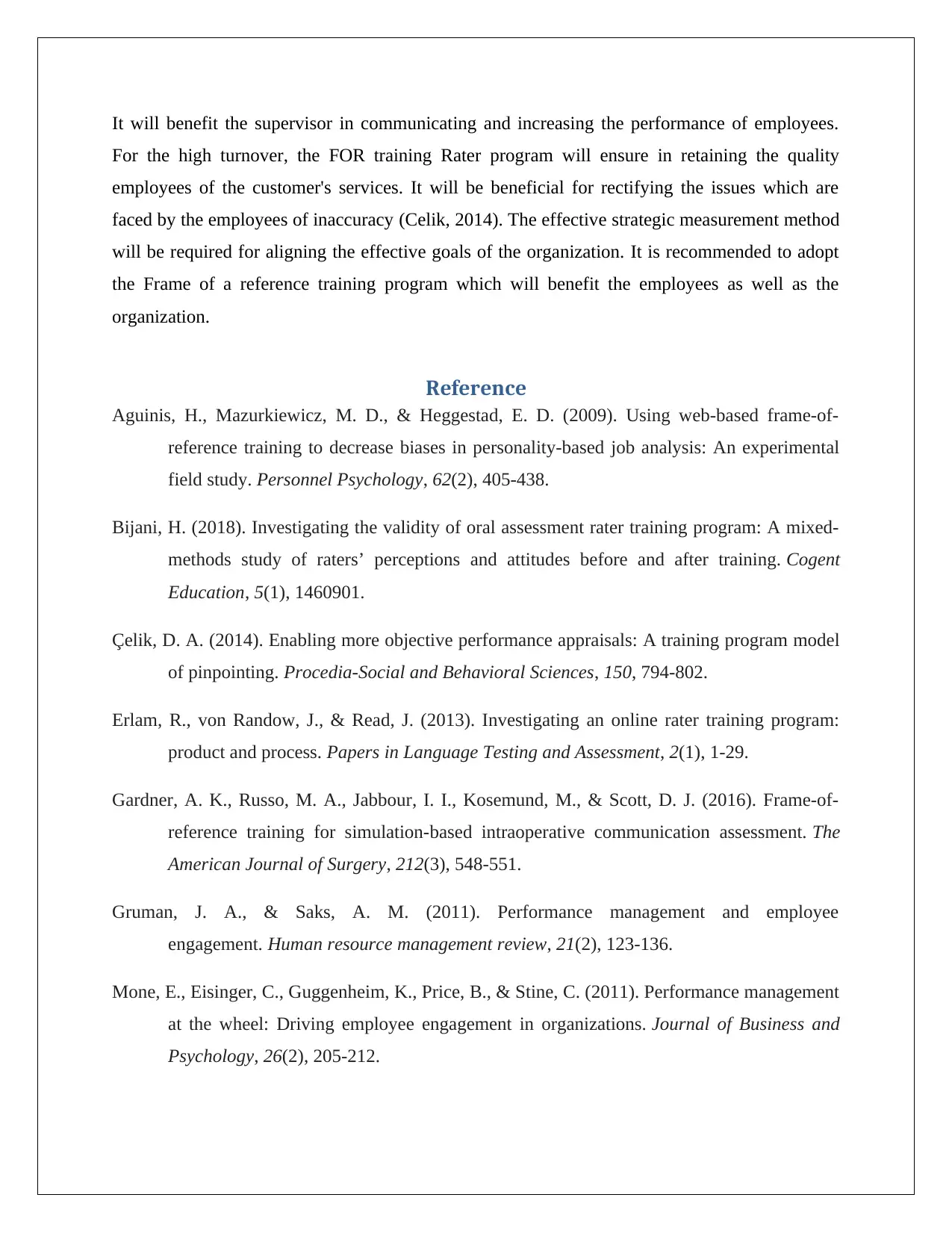
It will benefit the supervisor in communicating and increasing the performance of employees.
For the high turnover, the FOR training Rater program will ensure in retaining the quality
employees of the customer's services. It will be beneficial for rectifying the issues which are
faced by the employees of inaccuracy (Celik, 2014). The effective strategic measurement method
will be required for aligning the effective goals of the organization. It is recommended to adopt
the Frame of a reference training program which will benefit the employees as well as the
organization.
Reference
Aguinis, H., Mazurkiewicz, M. D., & Heggestad, E. D. (2009). Using web‐based frame‐of‐
reference training to decrease biases in personality‐based job analysis: An experimental
field study. Personnel Psychology, 62(2), 405-438.
Bijani, H. (2018). Investigating the validity of oral assessment rater training program: A mixed-
methods study of raters’ perceptions and attitudes before and after training. Cogent
Education, 5(1), 1460901.
Çelik, D. A. (2014). Enabling more objective performance appraisals: A training program model
of pinpointing. Procedia-Social and Behavioral Sciences, 150, 794-802.
Erlam, R., von Randow, J., & Read, J. (2013). Investigating an online rater training program:
product and process. Papers in Language Testing and Assessment, 2(1), 1-29.
Gardner, A. K., Russo, M. A., Jabbour, I. I., Kosemund, M., & Scott, D. J. (2016). Frame-of-
reference training for simulation-based intraoperative communication assessment. The
American Journal of Surgery, 212(3), 548-551.
Gruman, J. A., & Saks, A. M. (2011). Performance management and employee
engagement. Human resource management review, 21(2), 123-136.
Mone, E., Eisinger, C., Guggenheim, K., Price, B., & Stine, C. (2011). Performance management
at the wheel: Driving employee engagement in organizations. Journal of Business and
Psychology, 26(2), 205-212.
For the high turnover, the FOR training Rater program will ensure in retaining the quality
employees of the customer's services. It will be beneficial for rectifying the issues which are
faced by the employees of inaccuracy (Celik, 2014). The effective strategic measurement method
will be required for aligning the effective goals of the organization. It is recommended to adopt
the Frame of a reference training program which will benefit the employees as well as the
organization.
Reference
Aguinis, H., Mazurkiewicz, M. D., & Heggestad, E. D. (2009). Using web‐based frame‐of‐
reference training to decrease biases in personality‐based job analysis: An experimental
field study. Personnel Psychology, 62(2), 405-438.
Bijani, H. (2018). Investigating the validity of oral assessment rater training program: A mixed-
methods study of raters’ perceptions and attitudes before and after training. Cogent
Education, 5(1), 1460901.
Çelik, D. A. (2014). Enabling more objective performance appraisals: A training program model
of pinpointing. Procedia-Social and Behavioral Sciences, 150, 794-802.
Erlam, R., von Randow, J., & Read, J. (2013). Investigating an online rater training program:
product and process. Papers in Language Testing and Assessment, 2(1), 1-29.
Gardner, A. K., Russo, M. A., Jabbour, I. I., Kosemund, M., & Scott, D. J. (2016). Frame-of-
reference training for simulation-based intraoperative communication assessment. The
American Journal of Surgery, 212(3), 548-551.
Gruman, J. A., & Saks, A. M. (2011). Performance management and employee
engagement. Human resource management review, 21(2), 123-136.
Mone, E., Eisinger, C., Guggenheim, K., Price, B., & Stine, C. (2011). Performance management
at the wheel: Driving employee engagement in organizations. Journal of Business and
Psychology, 26(2), 205-212.
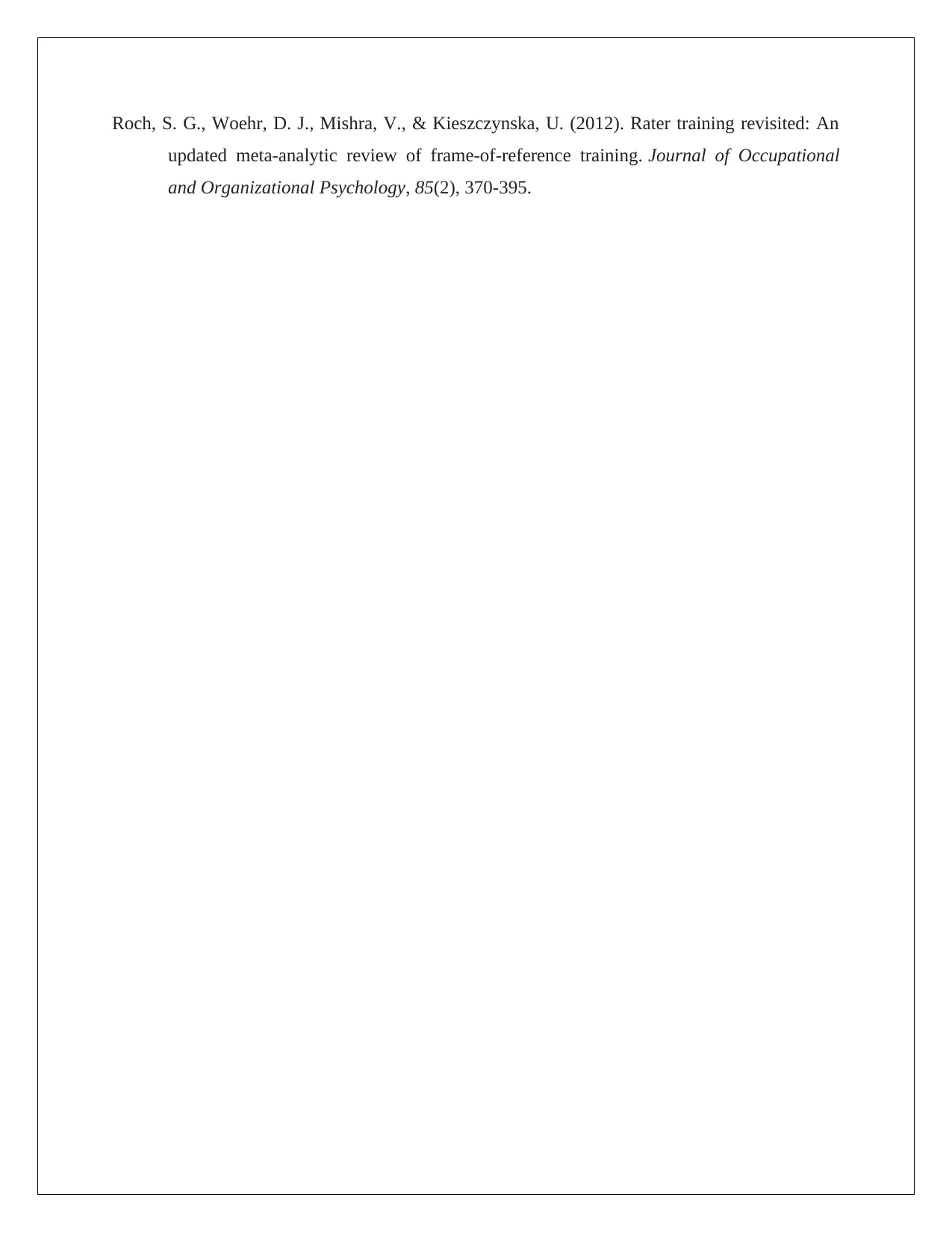
Roch, S. G., Woehr, D. J., Mishra, V., & Kieszczynska, U. (2012). Rater training revisited: An
updated meta‐analytic review of frame‐of‐reference training. Journal of Occupational
and Organizational Psychology, 85(2), 370-395.
updated meta‐analytic review of frame‐of‐reference training. Journal of Occupational
and Organizational Psychology, 85(2), 370-395.
⊘ This is a preview!⊘
Do you want full access?
Subscribe today to unlock all pages.

Trusted by 1+ million students worldwide
1 out of 6
Related Documents
Your All-in-One AI-Powered Toolkit for Academic Success.
+13062052269
info@desklib.com
Available 24*7 on WhatsApp / Email
![[object Object]](/_next/static/media/star-bottom.7253800d.svg)
Unlock your academic potential
Copyright © 2020–2025 A2Z Services. All Rights Reserved. Developed and managed by ZUCOL.





